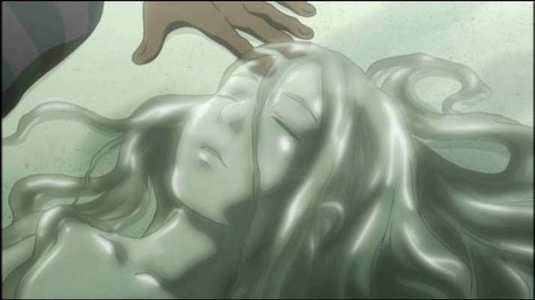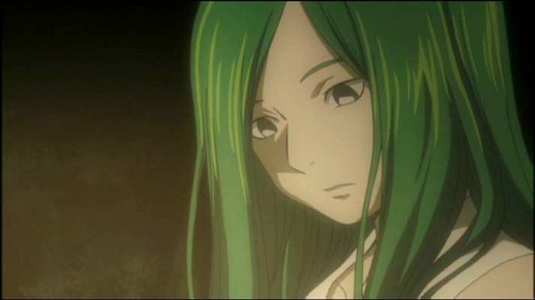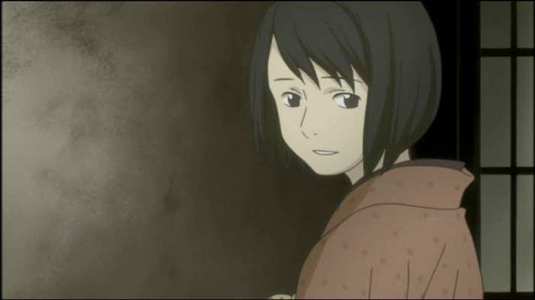Review of Mushi-shi: Volume 1
Introduction
Spooks and spectres figure strongly in Japanese folklore, there is a strong sense of spirituality and communion with nature that resonates all the way to modern entertainment, and it`s no surprise that Hollywood is now aping many Eastern horror films in order to breathe life into the putrid corpse of their entertainment industry. Naturally this fascination with the supernatural is a strong source of inspiration for manga and anime, and scarcely a year goes by that there aren`t ten or so such spooky series debuting in the UK market alone. You would think that with the abundance of vampires, ghosts, demons and spirits that there would come a point when the average anime fan would have seen it all, and would have nothing left to gain from yet another such series. But then Mushi-shi turns up for review, unlike anything I have seen before, and offering a new perspective on the supernatural.
Mushi are the most primitive of life forms. Elusive and ethereal, and existing since time immemorial, they have come to be the cause of many superstitions and supernatural legends. Ginko is a Mushi-shi, a Mushi Master. He travels the country investigating these odd creatures, and helping those people who, for good or ill wind up interacting with them. The first five episodes of Mushi-shi are presented in volume 1 from Revelation, along with more than the usual selection of anime extras.
1. The Green Seat
Shinra Ioroi is a young boy with a rare and dangerous talent. Whatever he draws with his left hand comes to life. Even the Japanese alphabet, based as it is on Chinese pictograms has the tendency to leap off the page. His grandmother kept him isolated, knowing that his talent would attract undue attention, and following her death he has followed her dictates, living alone in the country and avoiding all visitors. That`s until Ginko shows up. He knows that the boy`s ability has something to do with the way he perceives mushi, but he`s surprised to see that there is another spectral inhabitant of the house.
2. The Light Of The Eyelid
Sui is a sick young girl; she has contracted an illness that no one can cure, one that leads her to feel intense agony whenever she is in the light. It all began after she realised that when she truly closed her eyes, beyond simply shutting her eyelids, she was able to perceive something wondrous. Ginko realises that she has a mushi living in her eyes, and unless she can tear herself away from the mushi world, her illness will only get worse.
3. Tender Horns
Ginko treks through a silent winter landscape to get to a village afflicted by silence. There are a type of mushi, `Un`, that feed on sound, and in the silence of winter infect people to feed off the sound that their ears collect. It seems to be an easy problem to cure, but there is another more insidious mushi infection here. A young boy named Maho has gone beyond deafness and is now living in the clamour of another world. Suffering from the grief of losing his mother, he covered his ears and sprouted horns, the same illness that killed her. This mushi is called `Ah`, and there is no known cure.
4. The Pillow Pathway
Some time previously Ginko met a man named Jin who was suffering from premonitions in his dreams. Realising that his dreams were inhabited by mushi, and would eventually overwhelm him, Ginko gave him medicine to drive the dreams away. Some time later when Ginko returned to the village, he found it abandoned and rundown. Jin relates how his prognostic visions led him to lose everything including his family. Could Ginko have made a mistake?
5. The Travelling Swamp
Ginko has crossed the mountains to meet with an acquaintance. Dr Akashino is a scientist who has an interest in mushi, and Ginko has some tales to tell him. He has an ulterior motive though. During his trip, he kept encountering swamps, or rather a swamp, a living mire of liquid mushi that appeared to be following him. In the swamp there dwells an enigmatic green-haired girl, and Ginko wants to rescue her. But is he doing the right thing?

Video
Mushi-shi gets a 1.78:1 anamorphic transfer that aside from the odd artefact in the re-edited title sequence is free of any significant blemish. The transfer is as clear and sharp as NTSC-PAL gets, and the colours are lush and striking. This is an anime that takes the breath away in terms of the design and the animation. Mushi are a phenomenon strongly associated with nature, and Ginko`s travels take him to rural idylls and isolated communities in forests full of lavish greens, golds and browns. The character designs are simple but effective, but the thought gone into the animation takes it to theatrical quality. The limited palette of colours makes for an atmospheric piece, and the realisation of the ethereal mushi is stunningly accomplished. This is perhaps the most beautiful animation that I have seen this year.

Audio
You get sound in DD 2.0 stereo in English and Japanese flavours, along with translated subtitles and signs. The audio options are robust and surprisingly effective stereo tracks, with subtle sound design coming through the speakers. The effects reflect the gentle tone of the stories, and the music is atmospheric yet understated. This is a story where the sound of a footstep in snow, or the whisper of a breeze makes more impact than anything strident and obvious. It`s certainly one of the better stereo discs, but I wonder how much more effective a 5.1 soundtrack would have been, especially in the third episode that revolves around sound and its lack.

Features
The usual suspects here include a jacket picture, reversible sleeve for the Amaray case, trailers for the Full Metal Alchemist movie and Moon Phase, and the artefact free textless songs although only one of the end themes is here (Mushi-shi`s episodes all get different end themes that suit their particular stories).
Director Interview #1 - Ginko lasts 20 minutes and sees director Hiroshi Nagahama talk to voice actor Yûto Nakano about the show, the characters and the recording process.
Interview With The Director also lasts 20 minutes and Hiroshi Nagahama talks about what attracted him to the show, and the approach he took to the animation, especially keeping it grounded to the manga.
In the menu, the headings for these two featurettes have been swapped around, and clicking one will lead to the other. It`s a tiny goof.
Finally there is a Production Studio Tour that lasts 3 minutes and takes us into the director`s and the animators` workplace for a quick look-see at where the magic begins.

Conclusion
Mushi-shi is perhaps the most delicate anime that I have yet seen. That isn`t to say that the stories and the characters aren`t robust, it`s rather that the first things that strike you are just how beautiful the animation is, how important the sense of atmosphere, the tinges of mood, and the care with which the characters are developed. It`s a show that you experience rather than watch, stories that you bask in, and get caught up in the currents and eddies of narrative. It`s a thing of beauty, a work of art, and as such is open to a wide variety of criticism. I for one find the slow pace and ethereal stories wonderful and imaginative, although I can accept that this won`t appeal to those who look for livelier shows. It`s worth experiencing at least once though, if only because I have never seen its like before.
It`s true that anime about the supernatural, and spooky anthologies are two a penny. With Japanese folklore so replete with demons and small gods, there is a wealth of tales to be told, and shows like Vampire Princess Miyu and Requiem From The Darkness would offer something different each week. And on the surface Mushi-shi would appear to be in a similar vein. It`s completely different though, despite the episodic format. It begins with the simple premise that mushi, as lower, hidden forms of life are responsible for most of the superstitions about the supernatural, ghosts and demons and the like. But mushi have no motivation here, they are neutral, neither good nor evil, and it`s how they interact with humans that is of interest.
Ginko is an enigmatic character that is scarcely developed here, beyond a few hints and asides. He is a Mushi Master, who studies the small creatures, and helps those who have been affected by them. But he isn`t infallible and he makes more than one mistake in these episodes. The first episode is the most intriguing, as it indicates that mushi may have some intelligence and will, when they offer a gift to a human. It`s also a positive view of them that is fascinating. We draw back from that in the subsequent episodes, with an idea that mushi are more akin to disease, or at least responsible for sickness in humans. There is a touch of `curiosity killed the cat` in the second episode, and there is an indication that Ginko himself may have wandered too close to the edge in his enthralment, but it is the third episode that reveals mushi as most disease-like. Ginko`s fallibility is revealed when he tries to help a man who is afflicted by precognitive dreams, and the final episode truly brings Ginko to centre stage and questions his motives, as he tries to help a girl involved with mushi.
It`s rare to see an episodic anime these days, and if I had had a reservation about this series it would have been just that. But on occasion, the lack of an overarching storyline can be a pleasure rather than pain, and there is just enough continuity in the episodes to link them together. In this case, all of the episodes are so well written, and the various characters developed so strongly, that I would have no qualms if the whole series carried on in this vein. It`s rare that character motivation is examined so deeply, and emotions so well written, especially in half hour anime, that Mushi-shi really stands out in that regard. In fact it`s best served as episodic anime, and rather than succumb to the temptation to watch the whole disc in one setting, it`s far more rewarding to soak up an episode at leisure whenever you`re in the mood.
Mushi-shi is an anime that needs to be experienced. Buy it and bask in its brilliance.
Your Opinions and Comments
Be the first to post a comment!